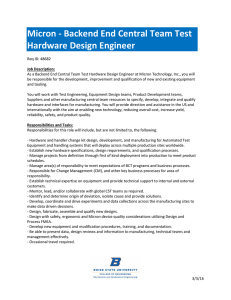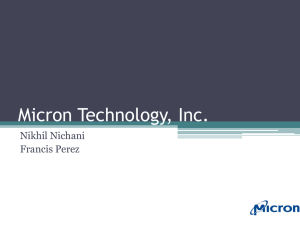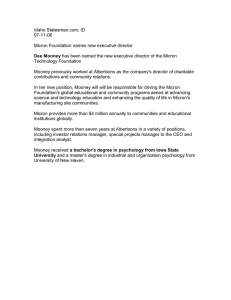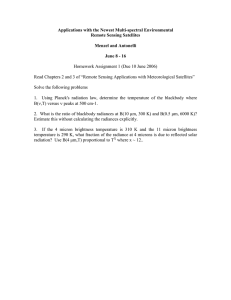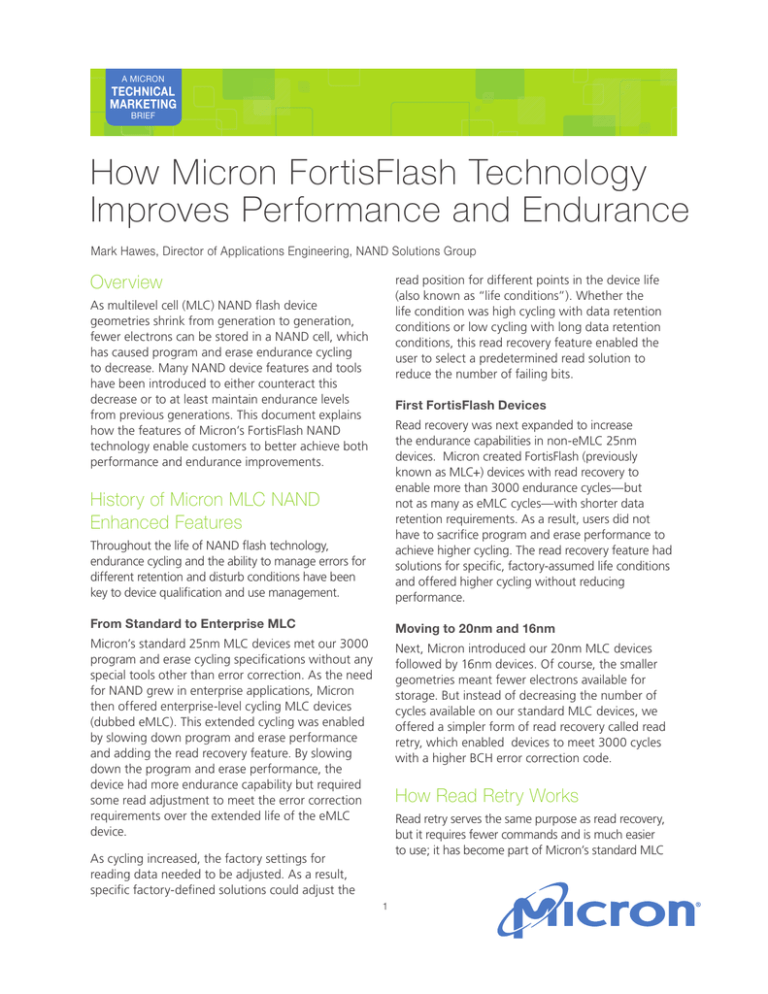
A MICRON
WHITE
PAPER
A MICRON
TECHNICAL
MARKETING
BRIEF
How Micron FortisFlash Technology
Improves Performance and Endurance
Mark Hawes, Director of Applications Engineering, NAND Solutions Group
Overview
read position for different points in the device life
(also known as “life conditions”). Whether the
life condition was high cycling with data retention
conditions or low cycling with long data retention
conditions, this read recovery feature enabled the
user to select a predetermined read solution to
reduce the number of failing bits.
As multilevel cell (MLC) NAND flash device
geometries shrink from generation to generation,
fewer electrons can be stored in a NAND cell, which
has caused program and erase endurance cycling
to decrease. Many NAND device features and tools
have been introduced to either counteract this
decrease or to at least maintain endurance levels
from previous generations. This document explains
how the features of Micron’s FortisFlash NAND
technology enable customers to better achieve both
performance and endurance improvements.
First FortisFlash Devices
Throughout the life of NAND flash technology,
endurance cycling and the ability to manage errors for
different retention and disturb conditions have been
key to device qualification and use management.
Read recovery was next expanded to increase
the endurance capabilities in non-eMLC 25nm
devices. Micron created FortisFlash (previously
known as MLC+) devices with read recovery to
enable more than 3000 endurance cycles—but
not as many as eMLC cycles—with shorter data
retention requirements. As a result, users did not
have to sacrifice program and erase performance to
achieve higher cycling. The read recovery feature had
solutions for specific, factory-assumed life conditions
and offered higher cycling without reducing
performance.
From Standard to Enterprise MLC
Moving to 20nm and 16nm
Micron’s standard 25nm MLC devices met our 3000
program and erase cycling specifications without any
special tools other than error correction. As the need
for NAND grew in enterprise applications, Micron
then offered enterprise-level cycling MLC devices
(dubbed eMLC). This extended cycling was enabled
by slowing down program and erase performance
and adding the read recovery feature. By slowing
down the program and erase performance, the
device had more endurance capability but required
some read adjustment to meet the error correction
requirements over the extended life of the eMLC
device.
Next, Micron introduced our 20nm MLC devices
followed by 16nm devices. Of course, the smaller
geometries meant fewer electrons available for
storage. But instead of decreasing the number of
cycles available on our standard MLC devices, we
offered a simpler form of read recovery called read
retry, which enabled devices to meet 3000 cycles
with a higher BCH error correction code.
History of Micron MLC NAND
Enhanced Features
How Read Retry Works
Read retry serves the same purpose as read recovery,
but it requires fewer commands and is much easier
to use; it has become part of Micron’s standard MLC
As cycling increased, the factory settings for
reading data needed to be adjusted. As a result,
specific factory-defined solutions could adjust the
1
A MICRON TECHNICAL
MARKETING BRIEF
How FortisFlash Technology Improves Performance and Endurance
offering. Like read recovery, read retry offers set
solutions for factory-predicted conditions throughout
the life of the device. Let’s look into how it works.
FortisFlash Is Feature-Rich
With Flexibility
MLC NAND storage cells have four states. At
Micron, we refer to them as Level 0, Level 1, Level 2,
and Level 3. These states are separated with margin
so that a read algorithm can identify one state from
another. Earlier MLC devices had enough electrons
to keep these states significantly separate through
the life of the device.
The expanded capabilities created by read retry
fit well with NAND device physics. The physics
show that higher cycling leads to more charge
loss. Therefore, the ability to let users select a
solution as the device ages is very powerful. But
the read retry options are still factory settings that
were meant for specific conditions. While most
applications fit into these factory settings, some
do not.
Data retention time can be defined as the time at
operating or storage temperature that a device can
still hold data and is still able to read one state from
another within the boundaries of the recommended
error correction. After cycling, the cell has a higher rate
of data or read threshold loss; therefore, more read
margin is needed to read the different states after data
retention—the more cycles, the more threshold loss.
Micron introduced FortisFlash to provide the ability
to optimize the NAND device for an application’s
specific use conditions. For some users, the
restrictions of read retry and the factory preset
solutions limited where and how far they could
take the NAND media. They wanted higher cycling
than standard MLC without needing the level
of cycling that Micron’s eMLC provides—and
they did not want to sacrifice program and erase
performance.
By creating a feature like read retry with variable
settings for different levels of cycling and retention,
the default factory settings do not have to support
life conditions from low cycle to high cycle and
all of the required retention possibilities. The read
retry feature has different read threshold settings
for each option that move the read state and
enable the read algorithm to keep these states
readable.
11
01
00
10
LO
L1
L2
L3
Micron’s FortisFlash offers a set of enhanced read
optimization (ERO) features. ERO features enable
more custom solutions by giving the user control
of the offsets for reading states. Our read offset
feature enables users to adjust each of the MLC
state read points to their needs. As a result, a user
can offset the read and create the best solution for
reducing the number of bits needing correction for
that specific point in the life cycle of the device.
DEFAULT
DISTRIBUTIONS
FortisFlash takes it one step further and enables
users to create custom, predetermined read
solutions for managing the NAND device and
enables them to determine when to apply these
solutions based on their own expertise or advanced
error management. Experienced users can apply
algorithms to reduce the delay caused by repeating
read retry attempts, and custom controllers are
able to manage at the highest efficiency.
VT
11
01
00
LO
L1
L2
AFTER CYCLING
AND DATA RETENTION
(Read Retry
Preset Options)
10
L3
Figure 1: Example of the Shift in State Threshold and
Read Threshold Created by Read Retry Options
2
A MICRON TECHNICAL
MARKETING BRIEF
How FortisFlash Technology Improves Performance and Endurance
Soft Data Features
The offset values and encoding are preset and
cannot be changed, but this method makes it
more straightforward to extract soft data. Soft
data read is ideal for users interested in adding
probability-based error correction (like LDPC)
without needing to control every aspect.
Hard data is raw data that needs to be corrected,
and soft data is the associated data that enables
users to determine the strength of (or confidence
in) the hard data. Micron’s FortisFlash technology
offers ERO features to gather soft data. The ability
to use soft data in an error correction scheme is
very powerful. Micron’s FortisFlash technology
offers this soft data using two methods:
SLC Mode
Micron’s FortisFlash technology also has the ability
to use blocks in a single-level cell (SLC) mode,
which enables data for firmware code or anything
that requires more data margin to be stored in a
highly reliable SLC block. SLC mode can also be
used to set aside blocks for caching purposes,
using SLC’s much faster programming and read
times; these SLC blocks enable much higher
endurance cycling than MLC. Countless use models
can take advantage of the SLC-enabled blocks
and are ideal when only a portion of the array
use application requires the advantages of SLC
performance.
>>Read
Offset: The read offset feature manually
offsets reads, extracts the raw data, and encodes
soft data from the device. The settings and
encoding can be custom-set. Using read offset
enables ultimate flexibility in soft data solutions.
Soft data can be very valuable in low-density
parity check (LDPC) or other probabilitybased error correction schemes. Read offset
also enables users to calibrate hard data read
settings to determine the correct placement for
the probabilities assigned to the soft data. This
feature’s capabilities are expanding and limited by
the user, not by Micron’s predetermined settings.
Read Performance
Micron’s FortisFlash technology includes product
offerings with Micron’s highest data read and data
input performance specifications, which increases
throughput and maximizes bus use. Micron NAND
uses the Open NAND Flash Interface (ONFI)
protocols.
>>Soft
Data Read: The automated soft data read
feature is easier to use than the manual read
offset feature. It gathers hard data, soft data,
and a level indicator bit. The soft data read
feature encodes soft data and enables a read
of the soft data as one bit per hard bit instead
of two pre-decoded offset bits per hard bit.
r01
r10
1’s 0’s
0’s 1’s
1
1
1
0
0
1
1
0
0
0
1
0
0
0
0
0
Hard Data
Soft Bit 1
Soft Bit 2
Level Indicator
0
0
0
1
L3
10
0
0
1
1
0
1
1
1
1
1
1
1
1
0
1
1
1
0
0
1
Hard Data
Soft Bit 1
Soft Bit 2
Level Indicator
Bin
6
Bin
7
Bin
8
Bin
9
Bin
1
Bin 0
11
1
0
1
0
Bin
0
Bin
1
Bin
2
Bin
3
Bin
4
Bin
5
1
0
0
0
L2
00
L1
01
LO
11
Summary of Features
Figure 2: Example of Hard Data and Soft Data for the Four
MLC States of an Upper Page Read
3
Overall, Micron’s 20nm and 16nm FortisFlash
technology offers flexible features that enable
users to take command of how the device
performs in their systems. FortisFlash also
enables users to expand cycling because they
can manage the read conditions that fit their use
model and ignore restrictions that are not part of
their conditions. FortisFlash ERO features can be
used for LDPC error correction or one of many
other user-engineered error correction methods
unique to users’ capabilities and needs.
A MICRON TECHNICAL
MARKETING BRIEF
How FortisFlash Technology Improves Performance and Endurance
Next-Generation FortisFlash
in 3D NAND
Micron’s FortisFlash technology built on 3D NAND
will further expand the ERO features with singlebit soft bit read, which will enable the flexibility
of manually setting soft data read windows along
with the convenience of being able to retrieve only
the encoded soft data. 3D FortisFlash will also
have a temperature sensor feature, additional sleep
power-saving modes, a peak power management
feature, and ONFI 4.0 NVDDR3 with its 1.2-volt
power savings and ability to achieve up to
667 MT/s.
As Micron begins creating our next generation
of NAND Flash using 3D technology, we will
be expanding our FortisFlash technology and
ERO features. Our standard MLC NAND on 3D
technology will offer the basic ERO features
that were available in 20nm and 16nm Micron
FortisFlash.
Our 3D-enhanced FortisFlash technology will offer
even more advanced features to expand user
capabilities, and it will offer easy-to-use tools along
with flexible solutions. For example, the calibration
function in our 20nm and 16nm FortisFlash devices
was enabled by the manual read offset feature.
While that feature will still be available for flexibility
and backward-compatibility, we will offer an
automated read calibration feature. This feature
will allow users to enable a calibration and initiate
a read, and the device will calibrate automatically
on the page being read. It has a longer tR time but
is much more efficient with less bus activity than
the manual method. Next-generation FortisFlash
technology further expands that capability by
enabling users to put the device into persistence
mode and use the last calibration for a page read
without paying the long tR time again. In addition,
users can retrieve these calibrated settings to do
everything from build multiple-page, average
settings for multiple tables to saving a calibration
before power-down.
Conclusion
Micron offers a variety of MLC NAND products for
various application needs. Of course, if standard
MLC meets the requirements of the application, it
will always be the lowest-cost MLC solution. For
applications that require more endurance, Micron’s
eMLC provides a “factory-configured” feature set
with maximum endurance for many use conditions.
For the sophisticated user that has somewhat
unique requirements, Micron’s FortisFlash
technology provides system customization
capability.
All of Micron’s FortisFlash technology features
further Micron’s commitment to offering flexible,
user-controlled capabilities for the advanced user
while still offering easier-to-use tools for “turn-key”
solutions. By putting these tools in the customer
development team’s hands, they can customize
their NAND solution based on their application’s
needs and their own error management knowledge
and engineering expertise.
micron.com
Products are warranted only to meet Micron’s production data sheet
specifications. Products and specifications are subject to change
without notice. The information contained herein is provided on an
“as is” basis without warranties of any kind.
©2015 Micron Technology, Inc. Micron and the Micron logo are trademarks of
Micron Technology, Inc. All other trademarks are the property of their respective
owners. All rights reserved. Rev. 2/15
4

